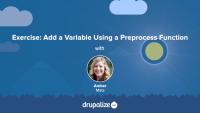Set up a local development environment to practice Drupal theme development exercises in our course, Hands-On Theming Exercises for Drupal.
By the end of this tutorial, you should be able to:
- Install Drupal on your computer, so you can edit files in your theme.
- Generate dummy content, so that you have different kinds of pages to theme.
It's time to create the bare-bones structure for a new theme on your site. You should try to complete this exercise based what you've learned from the tutorial prerequisites listed below. The video at the end of this tutorial will walk you through the implementation of this exercise if you need some help. In this exercise, we'll:
- Create an info file that describes a custom theme to Drupal with the regions listed below (we're going to name ours "reboot").
- Enable, and view, a bare-bones custom theme.
By the end of this exercise, you should feel comfortable starting a theme using several methods.
To add CSS or JavaScript files or libraries to your site, you can attach them as asset libraries in your theme. In this exercise, you'll create 2 asset libraries and attach them globally via your theme's info file. In this tutorial, we'll pull in the CSS and JavaScript from the popular Bootstrap framework so that we can make use of its layout utility classes later on. We'll also add a custom CSS file that contains global styles for our site, like setting the page background color.
If you want to try and complete this on your own first you'll need to:
- Add the Bootstrap CSS and JavaScript files to your theme.
- Define an asset library using a THEMENAME.libraries.yml file in your theme.
- Tell Drupal to attach your asset library so that the CSS and JavaScript files it represents are included in the page.
Once that's done your site won't look all that different. But if you view the page source, or look closely, you should see that the Bootstrap files are included along with any CSS rules you placed into your custom style sheet.
Note: Since this course is focused on teaching the Drupal aspects of theme development, and not on writing CSS, we're using the Bootstrap CSS. Feel free to use the framework or library of your choice if you don't want to use Bootstrap.
You should try to complete the exercise steps on your own and use the video to help guide you if you get stuck.
At the end of this exercise, you'll find a video walk-through of the solution.
Drupal has a few handy settings you can tweak to make developing themes a little more intuitive and a lot more awesome. In this tutorial, we'll practice manually setting up our environment for theme development by:
- Disabling some caches
- Turning off CSS and JS aggregation
- Turning on the Twig debug service
By the end of this tutorial, you'll have practiced setting up your environment for theme development.
In order to change Drupal's default markup you need to override template files. The page template controls the overall layout of your theme, including the placement of regions. You should practice the exercise following the written instructions below. Use the video walk-through to help if you get stuck.
In this exercise, we'll:
- Override the currently used page.html.twig template file.
- Modify the content of the file to include the regions defined in the theme's .info.yml file.
- Wrap the regions in the page template file with HTML markup using CSS classes from Bootstrap to achieve the example layout.
By the end of this tutorial, you'll gain practice creating a custom layout in a page template file.
The available dynamic tokens or variables vary from template to template. Each page is built from a set of templates.
In this exercise, we'll:
- Override and name the node template file so that it will only affect Article nodes on our Drupal site.
- Inspect the available variables.
- Customize the markup.
- Use the Twig filter
without.
We recommend that you try to work through the exercise yourself, and refer to the video if you need help.
In this exercise, we'll practice theming by overriding the main menu template. We'll:
- Override and rename the main menu template so that it will only affect the main menu component of our Drupal site.
- Add Bootstrap classes from the base nav component into our overridden main menu template file.
- Add CSS classes to HTML selectors using
attributes.addClass()andsetmethods.
We recommend that you work on the exercise steps below first. You can refer to the video if you need some help.
In this exercise, we'll continue our template overriding practice by overriding the image field template. We'll consult the Bootstrap documentation and add a responsive image class that will apply to any images uploaded by a user to the field_image field. Once again, we'll add this class to the classes array in the set Twig tag. You should work on the exercise steps below first, and you can refer to the video if you need some help.
In this exercise, we'll practice using the t filter in a Twig template. As a best practice, all hard-coded text in a template should be translatable. Simple text (containing no dynamic tokens) can be passed through the t filter to achieve this objective. Along the way, we'll also use a basic conditional if statement with Twig. We recommend that you try following the exercise's steps first, and refer to the video if you need help.
Preprocess functions allow you to change existing variables, or add new variables, for a template file using PHP code. In this exercise, you'll:
- Define a PHP function that implements a preprocess hook
- Create a new variable named
{{ today }}that contains the current date and gets passed to the page.html.twig template file.
We recommend that you try the exercise's steps first, and refer to the video if you need help.
Layout Builder is one of many different approaches to handling editorial layouts in Drupal. Now that it's stable, and part of Drupal core, we expect to see it become the dominant approach over time. However, as with most things in Drupal, there are multiple ways to solve the problem of creating component based flexible layouts that can be administered via the user interface.
It's a good idea to understand the different approaches and know what's available.
When it comes to component based design and ability to construct flexible layouts, it is important to understand the benefits and risks of the most popular techniques: Paragraphs, Bricks, entities and view modes, and Layout Builder. Understanding which approach fits the needs of your project best can be critical for its success in the future.
In this tutorial we'll look at some common approaches to administering layouts in a way that gives content editors controls including:
- Drupal core's Layout Builder
- Using core's entity reference fields and view modes
- The contributed Paragraphs module
- The contributed Bricks module
By the end of this tutorial you should have a broad overview of the different popular approaches to creating editor-controlled layouts.
In their simplest form layout plugins in Drupal Layout Builder define the part of the content output that can't be changed. For example a three column layout will consist of three equal columns every time an editor decides to use it as the layout section. The editor can place whatever they want into the three columns. But they can not change the overall layout. This restricts editorial capabilities of using layout plugins since in real life a three column layout may need to consist of a wider middle column and narrower side columns, allow for column headings, or other customizations.
This flexibility is accomplished by creating, and exposing, configuration options for layout plugins in Drupal's Layout Builder. In more advanced cases, we can take this flexibility further by exposing an interface editors to dynamically define layout plugins.
In this tutorial we'll:
- Learn how to use custom PHP classes in the layout plugin annotation
- Learn what annotations properties can be used for custom layout declaration
- Define the concept of derivatives and outline scenarios for using them
- How to declare static single layouts using YAML format
By the end of this tutorial you'll learn advanced ways of declaring configurable custom layout plugins.
A new favorite page-building and design module in Drupal's core software, Layout Builder makes it possible to create content-type-specific layouts. All nodes of the associated content type will display their content using the defined layout. This allows site builders to display a page's content in two columns, or three, or two columns with a full-width banner image, etc. Then you can place the content type's fields and Drupal blocks into the sections of the defined layout, all via the Drupal UI.
In this tutorial we'll:
- Enable the Drupal Layout Builder and Layout Discover modules
- Create a new two-column flexible layout via the user interface
- Update the Basic page content type so that all nodes use the new two-column layout
By the end of this tutorial you should know how to create a new flexible layout, and apply it to one or more content types.
When building with Layout Builder, the list of blocks available for a site administrator to place in a layout can grow and become overwhelming to navigate. This is especially true when you've got a lot of different modules enabled, as each can add new blocks. As well, complex configurations may require site admins to create more and more custom blocks. Some blocks, like certain Views, or default core blocks like "Who's online", are not meant to be used within the Layout Builder. These blocks can clutter the UI and also impact the performance of Layout Builder UI. The contributed module Block List Override is designed to help solve this problem.
In this tutorial we'll:
- Learn what the Block List Override module does
- Install and configure the module to improve the user experience when creating layouts
By the end of this tutorial you should know how to use the Block List Override module to improve the UX of the Layout Builder interface.
Layout Builder module comes with some common layouts that can be used out of the box. The Drupal community has created modules that provide more layout options. However, perhaps your project requires special layouts that cannot be constructed with already existing options. Or you require more precise control over the CSS classes and HTML markup, especially if your website is based on a third-party front-end framework. In these cases you can define custom layouts in a module or theme and make them discoverable by the Layout Builder.
In this tutorial we'll:
- Define a new layout plugin
- Create a corresponding Twig template file for HTML markup
- Use our new layout in the Layout Builder UI
By the end of this tutorial you should know how to define a new layout in code, within a module or a theme.
Layout plugins can be dynamically generated based on configuration using plugin derivatives. This allows developers to provide Drupal site administrators with a UI for creating new layout plugins, or to automatically register layout plugins based on the environment.
This is useful in situations where it's not enough to define a set of pre-configured layouts to use in the Layout Builder. Instead, you need to empower editors to declare their own new layout plugins without writing any code. Derivatives could also be used in scenarios where the layouts that should be made available depend on configuration set elsewhere in the module. Or, you might have a scenario where you want to have multiple different 2-column layouts, and for those layouts to have different names, so that they can be themed differently depending on which one is used.
In this tutorial we'll:
- Create a user interface that allows editors to dynamically define layouts via configuration.
- Learn how to set up a plugin deriver that creates layout plugins based on configuration.
- Create custom dynamic layout plugins with variable numbers of columns.
By the end of this tutorial you'll know how to declare dynamic custom layout plugins using derivatives.
When defining new layout plugins for Drupal you can add custom CSS and JavaScript via asset libraries. This allows for the creation of layouts with complex structures and interactive elements. Those elements might include grids, tabs, and accordions. Drupal allows you to attach custom CSS and JavaScript directly to a layout plugin, or via the layout's Twig template file.
In this tutorial we'll:
- Define a custom asset library with JavaScript and CSS functionality
- Attach the asset library to the custom layout plugin
- Transform a multicolumn layout into tabs
By the end of this tutorial you should know how to attach custom CSS and JavaScript to a layout plugin to add interactivity and styling.
One of the biggest UX problems with the current Layout Builder UI in core is that the control panel is often too narrow. This is especially noticeable when creating inline blocks, and working with WYSIWYG fields. The contributed Layout Builder Modal module is one solution to address this problem. It moves the UI for creating, and editing, custom blocks in a Layout into a wider modal window.
In this tutorial we'll:
- Install the Layout Builder Modal module
- Demonstrate how it can be used to improve the UX of managing custom blocks in Layout Builder
By the end of this tutorial you should know what the Layout Builder Modal module does, and determine if it's useful for your project.
The Layout Builder module for Drupal provides a layout user interface (UI), a set of flexible visual design tools that allows content creators and site administrators to customize the layout of a page via a powerful drag-and-drop UI. You can use Layout Builder to customize the layout of a single page, create a custom layout for all content of a certain type, or build landing pages.
At a high level it allows users to generate a layout -- two columns with a header, for example -- and then place a content type's fields and any blocks into that layout.
Layout Builder provides an API, and layout discovery feature, that themes and other modules can use to provide new templates. It allows more consistent tooling across the entire page-building ecosystem.
In this tutorial we'll:
- Give an overview of what Drupal Layout Builder is, and its common uses
- Introduce terminology and concepts related to Layout Builder
By the end of this tutorial you'll have a better understanding of what the Drupal core Layout Builder module does and how it might help with your specific use-case.
The Layout Builder Restrictions module allows you to configure which layouts, and which blocks, should be available in the Layout Builder UI. This helps improve the user experience by removing blocks that you don't want someone to place into a layout. It also restricts which layouts are available for a content type. For example, you may allow an editor to change the layout for a blog page but restrict them to choosing between 1- or 2-column layouts. Yet, you can still provide a 3-column layout option for use in other scenarios.
In this tutorial we'll:
- Install the Layout Builder Restrictions module
- Learn how to curate the list of layouts for use on a per-content type basis
- Restrict the list of blocks available for placement via Layout Builder's UI
By the end of this tutorial you'll know how to use the Layout Builder Restrictions module to curate the list of layout and block options available to editors in the Layout Builder UI.











